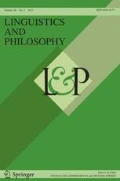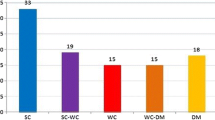Abstract
We show that Kubota and Levine’s (Linguist Philos 38:521–576, 2015) characterization of the HPSG-based theory of non-constituent coordination proposed in Yatabe (in: Flickinger, Kathol (eds) Proceedings of the 7th International Conference on Head-Driven Phrase Structure Grammar, CSLI, Stanford, pp 325–344, 2001) and later works is inaccurate, and that the theory in question does not require any ad hoc mechanisms to account for the long-known fact that right-node raising and left-node raising can affect semantic interpretation. In the course of demonstrating this, we fill in some details of this HPSG-based theory that were left unspecified in the previous literature, and we also present novel accounts of split-antecedent relative clauses and of respectively interpretation that are consistent with the theory. Furthermore, we argue that the phenomenon of summative agreement may provide a reason to prefer this theory over CG-based theories like Kubota and Levine’s.
Similar content being viewed by others
References
Abbott, B. (1976). Right node raising as a test for constituenthood. Linguistic Inquiry, 7, 639–642.
Abeillé, A., & Mouret, F. (2011). Quelques contraintes sur les coordinations elliptiques en Français. Retrieved August 27, 2016 from http://www.llf.cnrs.fr/Gens/Mouret/abeille-mouret-revised-2011.pdf.
Arnold, D. (2007). Non-restrictive relatives are not orphans. Journal of Linguistics, 43, 271–309.
Bachrach, A., & Katzir, R. (2007). Spelling out QR. In E. Puig-Waldmüller (Ed.), Proceedings of Sinn und Bedeutung 11 (pp. 63–75). Barcelona: Universitat Pompeu Fabra. http://parles.upf.edu/llocs/glif/pub/sub11/index.html.
Barwise, J., & Cooper, R. (1981). Generalized quantifiers and natural language. Linguistics and Philosophy, 4, 159–219.
Beavers, J., & Sag, I. A. (2004). Coordinate ellipsis and apparent non-constituent coordination. In S. Müller (Ed.), Proceedings of the 11th International Conference on Head-Driven Phrase Structure Grammar (pp. 48–69). Stanford: CSLI.
Brasoveanu, A. (2011). Sentence-internal different as quantifier-internal anaphora. Linguistics and Philosophy, 34, 93–168.
Chaves, R. P. (2014). On the disunity of right-node raising phenomena: Extraposition, ellipsis, and deletion. Language, 90(4), 834–886.
Chaves, R. P. (2007). Coordinate structures—constraint-based syntaxsemantics processing. Ph.D. thesis, University of Lisbon.
Citko, B. (2018). Complementizer agreement with coordinated subjects in Polish. Glossa, 3(1)(124), 1–25.
Copestake, A., Flickinger, D., Pollard, C., & Sag, I. A. (2005). Minimal recursion semantics: An introduction. Research on Language and Computation, 3, 281–332.
Culicover, P. W., & Jackendoff, R. (2005). Simpler syntax. Oxford: Oxford University Press.
Crysmann, B. (2003). An asymmetric theory of peripheral sharing in HPSG: Conjunction reduction and coordination of unlikes. In G.Jäger, P. Monachesi, G. Penn & S. Wintner (Eds.), Proceedings of Formal Grammar 2003 (pp. 47–62). http://cs.haifa.ac.il/~shuly/fg03/.
Dowty, D. (1988). Type raising, functional composition, and non-constituent conjunction. In R. T. Oehrle, E. Bach & D. Wheeler (Eds.), Categorial grammars and natural language structures (pp. 153–197). Dordrecht: Reidel.
Eggert, R. (2000). Grammaticality and context with respect to and.. and or... respectively. In A. Okrent & J. P. Boyle (Eds.), CLS 36: The main session (pp. 93–107). Chicago: The Chicago Linguistic Society.
Fox, D., & Johnson, K. (2016). QR is restrictor sharing. In K.-m. Kim, P. Umbal, T. Block, Q. Chan, T. Cheng, K. Finney, M. Katz, S. Nickel-Thompson & L. Shorten (Eds.), Proceedings of the 33rd West Coast Conference on Formal Linguistics (pp. 1–16). Somerville, MA: Cascadilla Proceedings Project.
Gawron, J. M., & Kehler, A. (2004). The semantics of respective readings, conjunction, and filler-gap dependencies. Linguistics and Philosophy, 27, 169–207.
Geurts, B. (2010). Quantity implicatures. Cambridge: Cambridge University Press.
Goodall, G. (1987). Parallel structures in syntax: Coordination, causatives, and restructuring. Cambridge: Cambridge University Press.
Gleitman, L. R. (1965). Coordinating conjunctions in English. Language, 41, 260–293.
Grosz, P. G. (2015). Movement and agreement in right-node-raising constructions. Syntax, 18, 1–38.
Hoeksema, J. (1986). An account of relative clauses with split antecedents. In M. Dalrymple, J. Goldberg, K. Hanson, M. Inman, C. Piñon & S. Wechsler (Eds.), Proceedings of the West Coast Conference on Formal Linguistics (Vol. 5, pp. 68–86). Stanford: Stanford Linguistics Association.
Hudson, R. (1976). Conjunction reduction, gapping, and right-node raising. Language, 52, 535–562.
Jackendoff, R. S. (1971). Gapping and related rules. Linguistic Inquiry, 2(1), 21–35.
Kamp, H., & Reyle, U. (1993). From discourse to logic: Introduction to modeltheoretic semantics of natural language, formal logic and discourse representation theory, part 1 and part 2. Dordrecht: Kluwer.
Kathol, A. (1995). Linearization-based German syntax. Ph.D. thesis, Ohio State University, Columbus.
Kathol, A. (1999). Agreement and the syntax-morphology interface in HPSG. In R. D. Levine & G. M. Green (Eds.), Studies in contemporary phrase structure grammar (pp. 223–274). Cambridge: Cambridge University Press.
Kathol, A., & Pollard, C. (1995). Extraposition via complex domain formation. 33rd Annual Meeting of the Association for Computational Linguistics (pp. 174–180). San Francisco: Morgan Kaufmann.
Kayne, R. S. (1998). Overt vs. covert movement. Syntax, 1, 128–191.
Kazenin, K. I. (2002). Gapping and some agreement puzzles. Ms., University of Tübingen. Retrieved February 7, 2002 from http://www.sfb441.uni-tuebingen.de/b2/b2pubs.html.
Kubota, Y. (2014). Medial right-node raising and multi-modal categorial grammar. http://ling.auf.net/lingbuzz/002302.
Kubota, Y., & Levine, R. (2015). Against ellipsis: Arguments for the direct licensing of ‘noncanonical’ coordinations. Linguistics and Philosophy, 38, 521–576.
Kubota, Y., & Levine, R. (2016). The syntax-semantics interface of ‘respective’ predication: A unified analysis in Hybrid Type-Logical Categorial Grammar. Natural Language & Linguistic Theory, 34, 911–973.
Kubota, Y., & Levine, R. (2018). On an inadequate defense of an ellipsis-based analysis for right node raising. http://ling.auf.net/lingbuzz/003852.
Landman, F. (2000). Events and plurality: The Jerusalem lectures. Dordrecht: Kluwer.
Levine, R. D. (2001). The extraction riddle: Just what are we missing? Journal of Linguistics, 37, 145–174.
McCawley, J. D. (1982). Parentheticals and discontinuous constituent structure. Linguistic Inquiry, 13, 91–106.
McCawley, J. D. (1988). The syntactic phenomena of English. Chicago: University of Chicago Press.
Morgan, J. L. (1984). Some problems of determination in English number agreement. In G. Alvarez, B. Brodie & T. McCoy (Eds.), Proceedings of the First Eastern States Conference on Linguistics (pp. 69–78). Columbus: Ohio State University.
Mouret, F. (2006). A phrase structure approach to argument cluster coordination. In S. Müller (Ed.), Proceedings of the 13th International Conference on Head-Driven Phrase Structure Grammar (pp. 247–267). Stanford: CSLI.
Neijt, A. (1979). Gapping: A contribution to sentence grammar. Dordrecht: Foris.
Perlmutter, D. M., & Ross, J. R. (1970). Relative clauses with split antecedents. Linguistic Inquiry, 1, 350.
Pollard, C. (2001). Cleaning the HPSG garage: Some problems and some proposals. Ms., Ohio State University, Columbus.
Pollard, C., & Sag, I. A. (1994). Head-driven phrase structure grammar. Chicago: University of Chicago Press.
Postal, P. M. (1994). Parasitic and pseudoparasitic gaps. Linguistic Inquiry, 25, 63–117.
Postal, P. M. (1998). Three investigations of extraction. Cambridge, MA: MIT Press.
Reape, M. (1994). Domain union and word order variation in German. In J. Nerbonne, K. Netter & C. Pollard (Eds.), German in head-driven phrase structure grammar (pp. 151–197). Stanford: CSLI.
Reinhart, T. (1983). Anaphora and semantic interpretation. London: Croom Helm.
Romoli, J., & Santorio, P. (2018). Filtering free choice. http://ling.auf.net/lingbuzz/003910.
Sag, I. A., Wasow, T., & Bender, E. M. (2003). Syntactic theory: A formal introduction (2nd ed.). Stanford: CSLI.
Schwabe, K. (2001). On shared indefinite expressions in coordinative structures. In O. Teuber & N. Fuhrhop (Eds.), ZAS Papers in Linguistics (Vol. 21, pp. 175–196). Berlin: ZAS.
Schwabe, K., & von Heusinger, K. (2001). On shared indefinite NPs in coordinative structures. Journal of Semantics, 18, 243–269.
Shen, Z. (2019). The multi-valuation agreement hierarchy. Glossa, 4(1), 1–29.
Shiraïshi, A., & Abeillé, A. (2016). Peripheral ellipsis and verb mismatch. In D. Arnold, M. Butt, B. Crysmann, T. H. King & S. Müller (Eds.), Proceedings of the Joint 2016 Conference on Head-driven Phrase Structure Grammar and Lexical Functional Grammar (pp. 662–680). Stanford: CSLI.
Sprouse, J. (2011). A validation of Amazon Mechanical Turk for the collection of acceptability judgments in linguistic theory. Behavior Research Methods, 43, 155–167.
Steedman, M. (1996). Surface structure and interpretation. Cambridge, MA: MIT Press.
Steedman, M. (2000). The syntactic process. Cambridge, MA: MIT Press.
Valmala, V. (2013). On right node raising in Catalan and Spanish. Catalan Journal of Linguistics, 12, 219–251.
Warstadt, A. (2015). Right-node wrapping: A combinatory account. In Y. Kubota & R. Levine (Eds.), Proceedings for ESSLLI 2015 Workshop ‘Empirical Advances in Categorial Grammar’ (CG 2015) (pp. 183–210). http://www.u.tsukuba.ac.jp/~kubota.yusuke.fn/cg2015.html.
Whitman, N. (2009). Right-node wrapping: Multimodal categorial grammar and the ‘friends in low places’ coordination. In E. Hinrichs & J. Nerbonne (Eds.), Theory and evidence in semantics (pp. 235–256). Stanford: CSLI.
Williams, E. (1990). The ATB theory of parasitic gaps. The Linguistic Review, 6, 265–279.
Yatabe, S. (2001). The syntax and semantics of left-node raising in Japanese. In D. Flickinger & A. Kathol (Eds.), Proceedings of the 7th International Conference on Head-Driven Phrase Structure Grammar (pp. 325–344). Stanford: CSLI.
Yatabe, S. (2003). A linearization-based theory of summative agreement in peripheral-node raising constructions. In J.-B. Kim & S. Wechsler (Eds.), Proceedings of the 9th International Conference on Head-Driven Phrase Structure Grammar (pp. 391–411). Stanford: CSLI.
Yatabe, S. (2004). A comprehensive theory of coordination of unlikes. In S. Müller (Ed.), Proceedings of the 11th International Conference on Head-Driven Phrase Structure Grammar (pp. 335–355). Stanford: CSLI.
Yatabe, S. (2007). Evidence for the linearization-based theory of semantic composition. In S. Müller (Ed.), Proceedings of the 14th International Conference on Head-Driven Phrase Structure Grammar (pp. 323–343). Stanford: CSLI.
Yatabe, S. (2009). Evidence for the linearization-based theory of long-distance scrambling in Japanese. In L. Uyechi & L.-H. Wee (Eds.), Reality exploration and discovery: Pattern interaction in language & life (pp. 271–286). Stanford: CSLI.
Yatabe, S. (2012). Comparison of the ellipsis-based theory of non-constituent coordination with its alternatives. In S. Müller (Ed.), Proceedings of the 19th International Conference on Head-Driven Phrase Structure Grammar (pp. 454–474). Stanford: CSLI.
Yatabe, S. (2015). The semantic inertness of medial right-node raising in Japanese. In Nihon Gengogakkai Dai-151-kai Taikai Yokô-shû (Proceedings of the 151st Meeting of the Linguistic Society of Japan) (pp. 318–323). Kyoto: Linguistic Society of Japan. http://ling.auf.net/lingbuzz/002778.
Yatabe, S. (2016). Medial left-node raising in Japanese. In D. Arnold, M. Butt, B. Crysmann, T. H. King & S. Müller (Eds.), Proceedings of the Joint 2016 Conference on Head-driven Phrase Structure Grammar and Lexical Functional Grammar (pp. 681–701). Stanford: CSLI.
Author information
Authors and Affiliations
Corresponding author
Additional information
Publisher's Note
Springer Nature remains neutral with regard to jurisdictional claims in published maps and institutional affiliations.
Rights and permissions
About this article
Cite this article
Yatabe, S., Tam, W.L. In defense of an HPSG-based theory of non-constituent coordination: a reply to Kubota and Levine. Linguist and Philos 44, 1–77 (2021). https://doi.org/10.1007/s10988-019-09283-6
Published:
Issue Date:
DOI: https://doi.org/10.1007/s10988-019-09283-6



